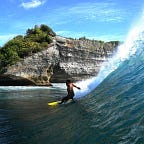Meet the only Ocean’s only insect
Imagine being shrunk by a laser and meeting this creature face to face.
Sea Skaters, also known as Ocean skaters (genus Halobates) are the only insects known to inhabit the ocean.
Startups & Ocean Tech / Conservation Tech
Because I subscribe to a fair few Oceanography newsletters for my work with Open Ocean Camera, I get cool tidbits of marine science research regularly trickling into my inbox.
Recently, the Scripps Institute ‘Explore’ newsletter dropped a gem about this little-known insect, here.
Interdisciplinary science (or Interdisciplinary STEM — Science, Tech, Engineering & Math) is commonly known to anyone engaged at college-level & beyond, and Ocean Skates do seem to present research opportunities on a few levels.
Oceanography & Marine Biology
From the ecology & evolution perspective, there are at least 3 species.
From an oceanography angle, the species have unique distributions corresponding to the ocean currents.
Engineering, Robotics & Bio-mimicry
From an engineering perspective, Ocean Skaters also seem to have great potential for robotics & biomimicry study. Their lightweight bodies support life on the water surface, from which they can break surface tension and leap. (More details here)
Their entire lives are spent on the harsh ocean surface, exposed to heat & UV, extreme salt, storms & currents.
“While taking off from the water surface, we observed H. germanus accelerate at around 400 m/s2,” says Thoroddsen. “Compare this with a cheetah or Usain Bolt, whose top accelerations taper off at 13 m/s2 and 3 m/s2, respectively. This extraordinary acceleration is due to the insect’s tiny size and the way it presses down on the water surface, rather like using a trampoline, to boost its jump.”
The wax secreted by the insect is of great interest to the team’s materials scientists, who are exploring new approaches for liquid repellent technologies. The insect’s hair structures are also informing the design of new materials.
“Inspired by the mushroom-shaped hairs of Halobates, my group is developing greener and low-cost technologies for reducing frictional drag and membrane fouling,” — Himanshu Mishra.
Robotics projects like the famous Boston Dynamics robot dog, or plastic-cleaning swarm ClearBot could benefit.
Read more on ocean skaters here, here & here.
#conservationtech #biomimicry #bluethoughts #oceanography
